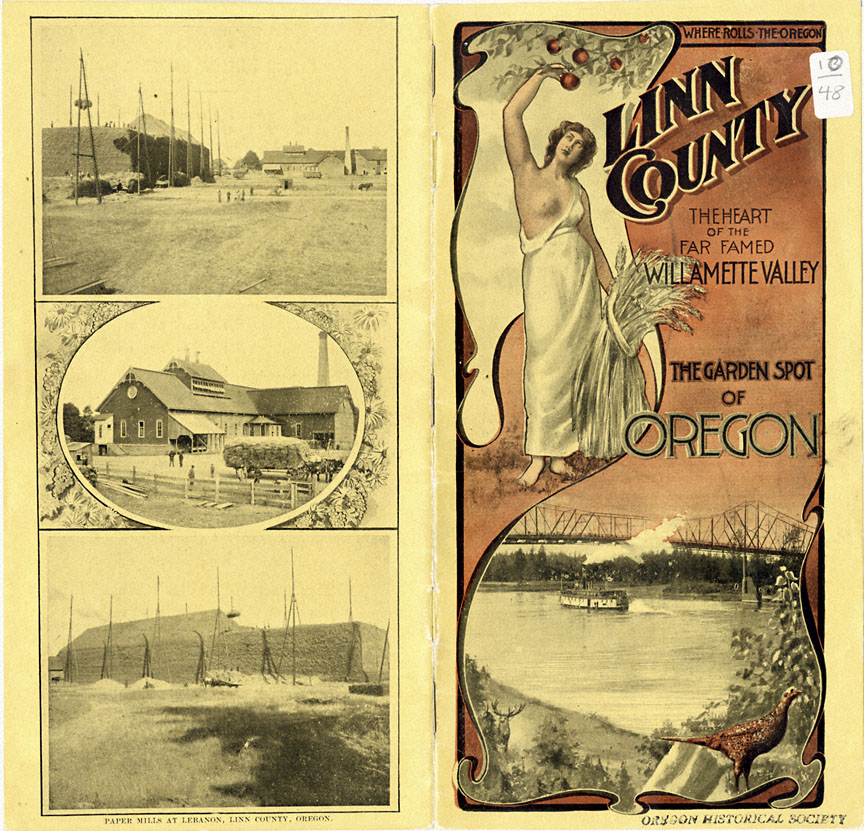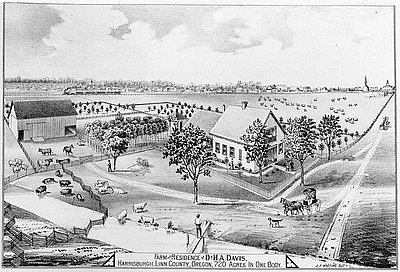- Catalog No. —
- Mss 6000
- Date —
- 1902
- Era —
- 1881-1920 (Industrialization and Progressive Reform)
- Themes —
- Agriculture and Ranching, Education, Environment and Natural Resources, Geography and Places, Trade, Business, Industry, and the Economy
- Credits —
- Oregon Historical Society
- Regions —
- Willamette Basin
- Author —
- Chamber of Commerce of Albany, Oregon
Linn County Promotional Brochure
This image shows the front and back covers of a promotional pamphlet published by the Commerce Committee of Albany about 1902. When this pamphlet was printed, Linn County was just emerging from an economic depression that had slowed regional agricultural and industrial growth between 1890 and 1900, and it is designed to encourage economic recovery.
The images illustrate the changing nature of the Linn County economic base around the turn of the nineteenth century. The depiction of a classical harvest goddess on the front cover represents the bounty of the Willamette Valley’s agricultural economy, while the three views of the Lebanon Paper Mill on the back cover speak to the growing industrial nature of the Linn County economy. The mill, which was originally subsidized by $5,000 raised from local citizens in 1890, began producing paper from straw in 1892 and soon thereafter expanded its operations to include wood pulp processing. By promoting both agriculture and manufacturing, the Commerce Committee hoped to draw both traditional and modern industries to Linn County.
In addition to promoting the economic benefits to be found in Linn County, the pamphlet also advertised the quality of life in the county, providing detailed information about the strength of the local schools, the presence of Albany College (now Lewis and Clark College), and the number of churches to be found. It includes a chart that shows the average rainfall and number of sunny days in this part of the Willamette Valley. Oregon’s reputation for wet and dreary weather is not omitted, and newcomers are warned that the winter mud and clouds can be a depressing part of Oregon’s winter season.
Promotional pamphlets such as this one have a long tradition in Oregon and the Pacific Northwest, and they have been used since the early days of settlement to encourage immigration. Pamphlets, letters, and other forms of boosterism played an integral role in helping to shape the regional identity for those viewing Oregon from outside the regions as well as for those who actually lived here. Railroads and land speculators described the Northwest as a “utopia” and an “Eden” in order to draw new immigrants to the region. Settlers already living in Oregon helped perpetuate the image of an agricultural paradise by way of their letters to friends and family in other parts of the country. The identification of Oregonians as independent and resourceful drew upon the pioneer experience and helped establish an identity that inhabitants of the state readily adopted and proudly claim to this day. One need look no further than slogans such as “Oregon: Things look different here” or “Oregon: We love dreamers” to see that boosterism is still an integral part of shaping the identity of Oregon.
Further Reading:
Wheeler, L.M., ed. History of Linn County, Oregon. Portland, Oreg., 1882.
Pioneer Stories of Linn County, Oregon: W.P.A. Interviews by Leslie L. Haskin, et al. / copied and indexed by Nina L. Williamson ... [et al.]. Albany, Oreg., 1984.
Mullen, Floyd C. The Land of Linn: an historical account of Linn, County, Oregon. Lebanon, Oreg., 1971.
Written by Dane Bevan, © Oregon Historical Society, 2003.

